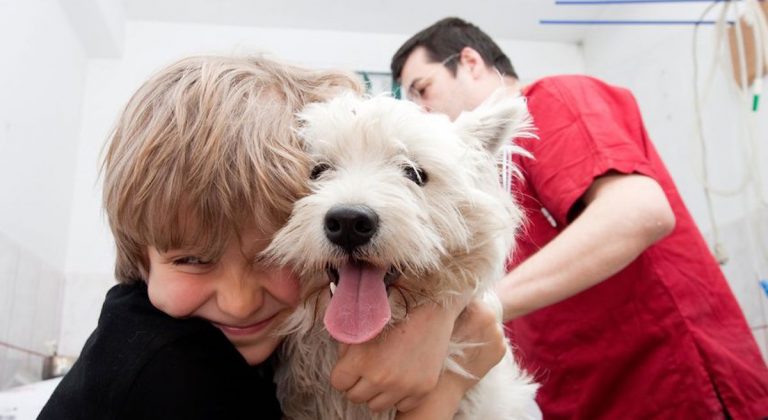How to Administer Dog Medicine Like a Pro
Learn how to give your dog all those medications she really doesn’t want to take, from pills to injections. Expert advice from a vet tech.

Getting your dog to take her medicine can be like putting toothpaste back into the tube… It needs to be done, but can seem an impossible task at the time. If your dog is anything like one of mine, you’ll have to drag her out from under the bed to medicate her.
AND… If you’re anything at all like my husband, making your pooch the least bit uncomfortable sends you into reams of guilty feelings that can cause you to quit the job way too easily.
There are ways to give your pet her medicine without traumatizing either one of you.

Don’t leave your pet’s safety to chance
Sign up for Petful recall alerts today.

How to Administer Pills
One of the most common forms of medicine you’ll get from your veterinarian comes in pill form. Whether it’s an antibiotic that you must give for only 10 to 14 days, or a thyroid hormonal supplement that your dog requires a couple of times a day for life, getting those pills down your dog’s throat is the ultimate goal.
- For dogs that don’t have weight or diabetic issues, the easiest way to give a pill is to pop it into a small chunk of hot dog or cheese. You just need to have a big enough bite of food to cover the pill. Push the pill all the way into the middle of the food so it can’t be seen, and offer it to her as a treat.
- Or if your dog is a fan of peanut butter, stick the pill into the middle of a spoon of peanut butter and let her lick it up. With her favorite treat hiding the pill, your pet is more likely to swallow the medicine without even thinking about it.
For those animals that can smell one tiny pill in a plateful of hot dogs and eat around it or spit it out, you’re going to need another plan. Here are two more methods:
PILLER: You can buy a “piller” at your vet’s office or at some pet supply stores. The piller looks like a long, plastic tube with a plunger on one end and a rubber cylinder on the other, and is designed to hold different sizes of pills.
Once you place the medicine in the holding end of the piller and draw back the plunger, open your dog’s mouth just wide enough to get the pill all the way over her tongue to the back of her throat. When the pill is in the right spot, push down on the plunger, quickly pull out the piller — making sure you’ve left the medication behind — and gently hold her muzzle shut. Point her nose to the ceiling and rub her throat to encourage her to swallow the pill.
OR JUST SHOVE IT DOWN: Gently pry her mouth open with one hand, then, with your other hand, push the pill to the back of her throat, making sure you set it over the base of the tongue. Hold her mouth closed, gently push her nose to the ceiling, and rub her throat until you feel her swallow.
If your pup is reluctant to swallow the pill, you can try gently blowing into her nose. The air flowing backward into her lungs causes an automatic swallow reflex that will get the medicine down her throat and into her stomach.
Liquid Medicines
You’ll probably find that giving your dog liquid medicines is an easier proposition than pilling her.
- Once the proper dosage of liquid is drawn up into the medicine dropper or syringe, gently slip the end of the applicator into the side of your pup’s mouth in the pouch between her cheek and gums.
- Point her nose to the ceiling and slowly expel the medicine into her mouth, allowing her time to take a breath between each swallow.
- Keep giving her the liquid until she has swallowed the prescribed dose.

Ear Medications
If your pet has any kind of ear disease caused by bacteria, yeast or even ear mites, you’re going to have to treat her ears at home with either a medicated ointment or a liquid to clear up the infection.
Your dog’s ear consists of the earflap (or pinna) and the outer, middle and inner ear canals. For minor infections, you’re going to be treating only the pinna and outer ear canal.
- Hold your dog’s ear open and gently pull up from the base of the ear to straighten the L-shaped ear canal.
- Place the tip of the applicator bottle or tube into the outer part of her canal and squeeze the prescribed number of drops into the ear. By stretching her ear away from her head, you allow the medicine to be deposited over all the little valleys of the ear canal.
- Gently massage the base of the ear to distribute the medication evenly. I stress the word gently because her ears might be particularly sensitive and painful from the infection. Make sure that the underside of the earflap also receives enough of the medicine to cover it.
Eye Meds
Giving your dog eye medications can seem particularly scary, especially if your pet is a squirmy little thing, so you may want to ask someone to help you hold her head while you do so.
- Gently open her eyelids with the fingers of your non-dominant hand. If you are right-handed, that would be your left hand.
- Hold the open tube or bottle of medication in the other hand with the tip of the applicator approximately ½ inch above her eye orb, making sure not to touch the eye. Drip the prescribed number of drops or ½ inch of gel down onto the eye and allow the eyelids to close.
- Gently massage the eyelids to evenly distribute the medication over the entire eye.
Subcutaneous (“Under the Skin”) Injections
If your dog is diabetic or needs regular allergy injections, you need to learn how to give her a shot of medicine subcutaneously — that is, just under the first layer of skin.
- Draw up the proper amount of medicine in your syringe and replace the cap so that you don’t stick yourself with the needle.
- Place your dog in your lap or ask someone to hold her for you. Once she is relaxed and comfortable, pull up a loose flap of skin between her shoulder blades so that it forms a “V.”
- Remove the cap from the needle and syringe and quickly thrust the needle into the middle area of the “V,” making sure it doesn’t come through the other side of the skin. Most diabetic and allergy syringes have very small, thin needles, so if you push the needle in quickly, all your dog will feel is a tiny pinch.
- Pull back on the syringe’s plunger and look for any blood filling the tube. If you see blood, you have accidentally hit a small capillary and you’ll need to reposition the syringe. If you don’t see any blood, gently push down on the plunger until all the medicine is dispensed.
Giving your dog medicine takes a little time and patience, but with the proper techniques the process can be fairly easily and stress-free for both of you.
Additional Resources
Washington State University College of Veterinary Medicine has some great ideas (including pictures) to show you how to administer the dog medicines discussed above:
- Giving oral medications
- Examining and medicating the eyes
- Cleaning and medicating dog ears
- Giving subcutaneous fluids









